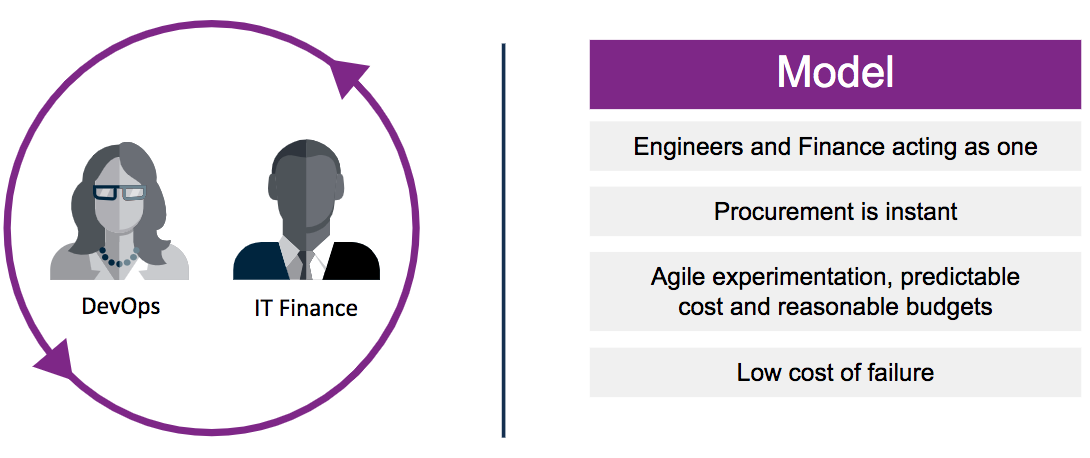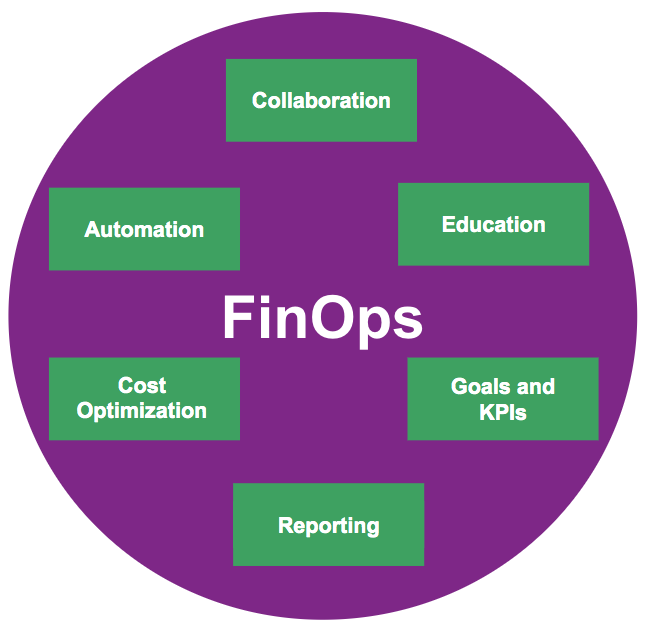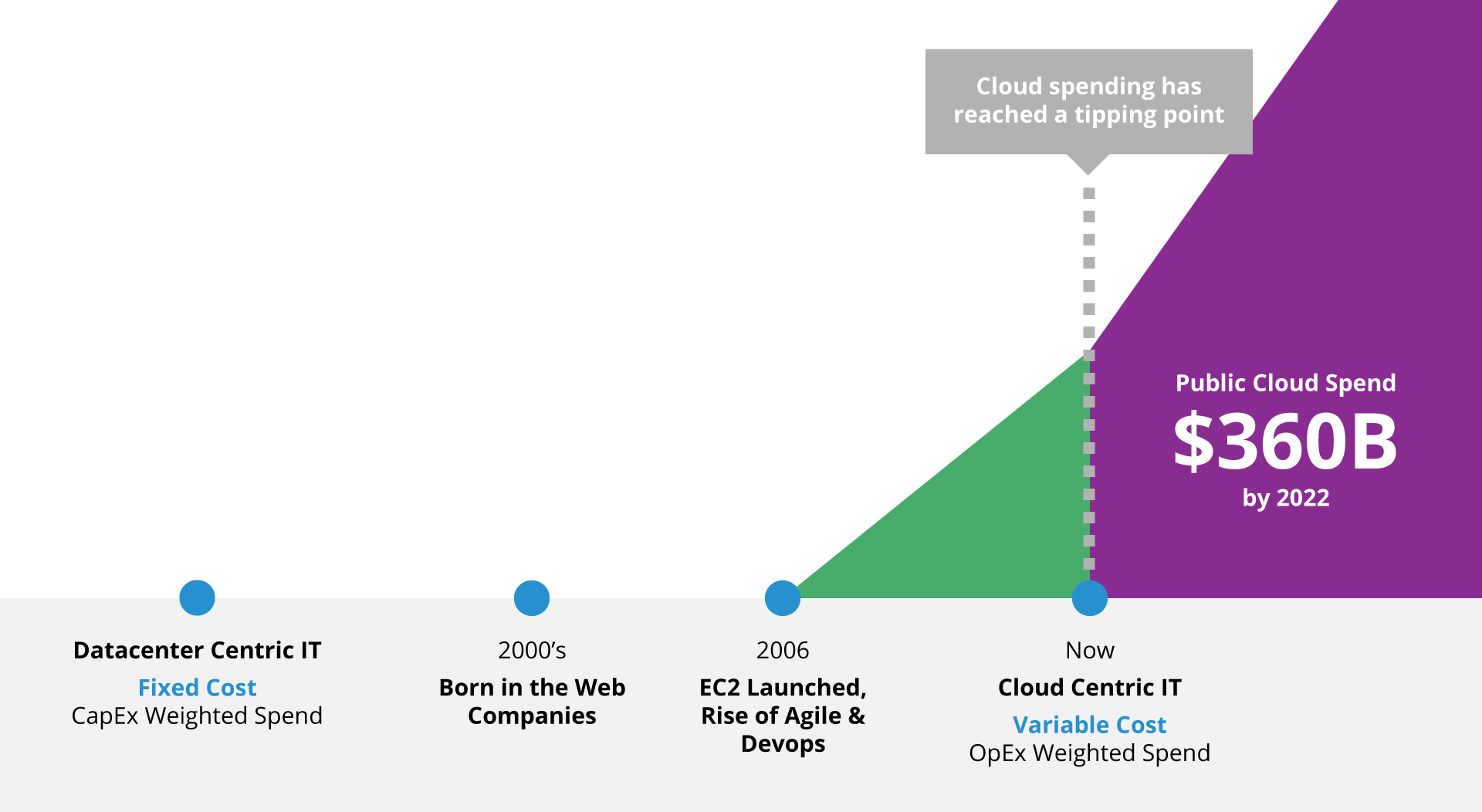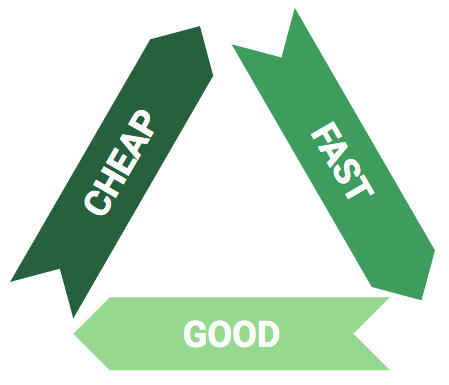FinOps
History
Trailblazers like Adobe and Intuit, early scalers in public cloud, gave us our first glimpse into what would become FinOps around 2012 in San Francisco. A couple years later, we saw forward-looking enterprises in Australia, like Qantas and Tabcorp, begin a similar practice. In the UK, we saw enterprises like BP and Sainsbury’s as they developed this new approach across their cultures. FinOps came into being, slowly, all over the world as the financial and accountability challenges of cloud presented themselves at scale in each territory.
"FinOps" is a term that has come late to the party. In the early days, companies were simply calling the practice "cloud cost management." Later, "cloud cost optimization" began to take hold, although it didn’t speak to the allocation challenges of cloud. AWS and other cloud providers began using the phrase "cloud financial management," a catch-all title that was eventually replaced by "FinOps." Choosing this compound term, which purposely echoes DevOps, brings the vital cross-functional and agile aspect of the movement to the forefront.
And now, FinOps is being adopted worldwide. Recently, Nike posted a director-level job role in their newly formed Cloud Business Office. Southwest Airlines formed a FinOps Business Office. And now, job listings on LinkedIn for FinOps Managers are popping up more frequently in big cloud enterprises like Pearson, Spotify, and Randstad. Tech unicorns like Atlassian have begun operationalizing FinOps through their team collaboration software.
In short: FinOps ensures you get the most value out of every dollar you spend in the cloud. It is the practice of bringing financial accountability to the variable spend model of cloud, enabling distributed teams to make business trade-offs between speed, cost, and quality.

No longer is a siloed procurement team identifying costs and signing off on them. Instead, a cross-functional FinOps team adopts a definitive series of procurement best practices, enabling them to pull together technology, business, and finance in order to optimize cloud vendor management, rate, and discounting.
With FinOps, each operational team (workload, service, product owner) can access the near-real-time data they need to influence their spend and help them make intelligent decisions that ultimately result in efficient cloud costs balanced against the speed/performance and quality/availability of services.

Much of the focus of companies adopting cloud is on Cost Optimization, but while Cost Optimization is indeed a key part of what FinOps focuses on, it is only a part of the picture.
A successful FinOps practice will focus on building a culture of accountability within the organization, one in which everyone works collaboratively to meet common goals, to understand the organization’s cloud use, to report on it effectively and transparently, and, yes, to optimize cost and usage to achieve the best value for each cloud dollar spent.
Principles
-
Teams need to collaborate.
First and foremost, FinOps is about cultural change, breaking down the silos between teams that, historically, haven’t worked closely together. When this is done right, the finance team uses language and reporting that moves at the speed and granularity of IT, while engineering teams consider cost as a new efficiency metric. At the same time, the FinOps team works to continuously improve agreed-upon metrics for efficiency. They help define governance and parameters for cloud usage that provide some control, but ensure innovation and speed still flourish.
-
Decisions are driven by the business value of cloud.
Think first about the business value of cloud spend, not the cost. It’s easy to think of cloud as a cost center, especially when the spend reaches material levels. In actuality, cloud is a value creator, and the more you use it, the more cost it will incur. The role of FinOps is to help maximize the value created by the spend. Instead of focusing on the cost per month, focus on the cost per business metric, and always make decisions with the business value in sight.
-
Everyone takes ownership for their cloud usage.
Cloud costs are based on cloud use, which comes with a straightforward correlation: if you’re using the cloud, you’re incurring costs, and, thus, accountable for cloud spending. Embrace this fact by pushing cloud spend accountability to the edges of your organization, all the way to individual engineers and their teams.
-
FinOps reports should be accessible and timely.
In the world of per-second compute resources and automated deployments, monthly or quarterly reporting isn’t good enough. Real-time decision making is about getting data, such as spend changes or anomaly alerts, quickly to the people who deploy cloud resources. Real-time decisions enable these people to create a fast feedback loop where they can continuously improve their spending patterns, make intelligent decisions, and improve efficiency.
Focus relentlessly on clean data to drive decisions. FinOps decisions are based on fully loaded and properly allocated costs. These are the true costs for operating in the cloud. These costs should be amortized, to reflect the actual discounted rates a company is paying for cloud resources; equitably factor in shared costs; and be mapped to the business’s organizational structure. Without these adjustments to your spending data, your teams will make decisions based on bad data and hamstring value creation.
-
A centralized team drives FinOps.
Cultural change works best with a flag bearer. A central FinOps function drives best practices into the organization through education, standardization, and cheerleading. Maximize the results from rate optimization efforts by centralizing them, which gives your teams on the edge the freedom to maximize the results from usage optimization. Remember, the most successful companies decentralize using less, and centralize paying less.
FinOps practitioners use performance benchmarking in order to provide context about how well their organization is performing. Cloud performance benchmarking gives a company objective evidence on how well it’s doing. Benchmarking lets teams know if they’re spending the correct amount, or if they could be spending less, spending differently, or spending in a better way. Companies should use both internal benchmarks to determine how individual teams compare to each other in key areas like optimization, and external benchmarks based on industry standards to compare the company as a whole to others like it.
-
Take advantage of the variable cost model of the cloud.
In the decentralized world of the cloud, planning for capacity moves from a forward-looking, "What are you going to need to cover demand?" perspective to a backward-looking, "How can you ensure you stay within your budget given what you’re already using?" perspective. Instead of basing capacity purchases on possible future demand, base your rightsizing, volume discounts, and RI/CUD purchases on your actual usage data. Since you can always purchase more capacity to fit demand, the emphasis becomes making the most out of the services and resources you’re currently using.
The Rise of the Cloud Economy

Cloud spend has begun to hit a tipping point. This Gartner forecast puts it at $360B by 2022. The actual number may end up even higher. In our experience, organizations underestimate their cloud spend and industry forecasts are regularly revised upward. Cloud spend is becoming a material part of organizational budgets, impacting both the bottom and top lines for enterprise P&Ls.
And with all that growth, the time-honored silos between tech, finance, and procurement have become a problem. To understand why, let’s look to our favorite definition of cloud by Dave Nielsen back in 2011. In order to be called "cloud," Dave said an infrastructure provider had to be "OSSM":
- On-demand
- Scalable
- Self-service
- Measurable
Addressing Cloud Challenges

Mastering the Cloud is not just a technology problem or a business problem or a system problem. It is very multi-faceted, involving people, process and technology, and ultimately affecting the culture of the organization as a whole.
FinOps seeks to guide actions to maximize the value of cloud spend, but decisions must be made on an “Iron Triangle.”
Tradeoffs must be made by balancing the company’s goals in every case in terms of how fast, how good and how cheap to develop. The goal of FinOps is not always to do things the cheapest, but to do things in the way that develops the most value.